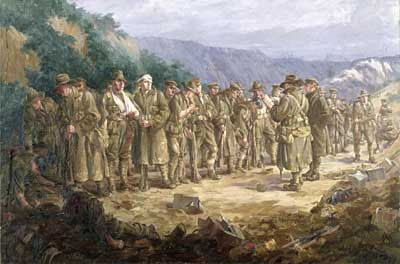 This sketch is one of twelve small studies in oil panel (Seurat called them croquetons - little sketches) painted at Grandcamp on the Normandy coast in the summer of 1885. They are Seurat's first marine landscapes. Of this group of sketches, two served as a basis for large canvases. The National Gallery of Australia's sketch provided the basis for Le Bec du Hoc, Grandcamp 1885, now in the Tate Gallery, London.
This sketch is one of twelve small studies in oil panel (Seurat called them croquetons - little sketches) painted at Grandcamp on the Normandy coast in the summer of 1885. They are Seurat's first marine landscapes. Of this group of sketches, two served as a basis for large canvases. The National Gallery of Australia's sketch provided the basis for Le Bec du Hoc, Grandcamp 1885, now in the Tate Gallery, London.The composition of the croqueton, painted on the spot, differs in some respects from the finished painting, which was almost certainly worked up in the studio after Seurat's return to Paris. The study shows the rocky shoreline at the base of the cliff, whereas in the final painting this is excluded (as if the tide had come in), allowing the direct juxtaposition of the promontory, a swooping arc against the unrelieved horizontal of a calm sea. The expressive qualities of the composition are drawn out in the final painting: a flock of birds appears above the point of the promontory, a lone white sail can be seen on the horizon. 'From the precipitous coast of Grandcamp', wrote the critic Félix Fénéon (1861-1944) of the painting in 1888, 'the little promontory of Bec du Hoc soars over the quiet, melancholy sea'.
The idea of painting the promontory from above may have been suggested to Seurat by the vertiginous cliff paintings that Claude Monet executed on the Normandy coast a few years earlier (at Fécamp in 1881 and at Varengeville, Pourville and Dieppe in 1882) and which were exhibited in Paris in 1882 and 1883. It has also been suggested that the simplified silhouette of Le Bec du Hoc may have been inspired by Japanese woodblock prints, specifically the towering wave in Katsushika Hokusai's The great wave of Kanagawa from Thirty-six views of Mount Fuji of about 1825.
adapted from Michael Lloyd and Michael Desmond, European and American Paintings and Sculptures 1870-1970 in the Australian National Gallery, 1992, pp.64-67 by Christine Dixon
1. 'De l'abrupt littoral de Grandcamp … le petit promontoire du Bec du Hoc se hausse hargneusement sur la mer calme et triste' (Félix Fénéon: 'A La Revue Indépendante: La Revue Indépendante March 1888', in Félix Fénéon, Oeuvres plus que complètes, 2 vols, Geneva, 1970, vol. 1, p.98).
2. Henri Dorra and Sheila C. Astin, 'Seurat's Japonisme', Gazette des Beaux-Arts, vol.73 no.1201, February 1969, pp.81-94, cf. p.85. This argument is developed further by Françoise Cachin, 'Les Neo-Impressionistes et le Japonisme, 1885-1893', in Japonisme in Art: An International Symposium, ed. Society for the Study of Japonisme, Tokyo: Kodansha International 1980, pp.225-238.










